Lands of the Bohemian Crown
Lands of the Bohemian Crown | |
|---|---|
| 1348–1918 | |
States of the Holy Roman Empire (1348–1806),Latin | |
| Religion | Official religions:
|
| Government | Monarchy |
| King | |
• 1346–1378 | Charles I (first) |
• 1916–1918 | Charles III (last) |
| History | |
• Bohemian Crown established | 7 April 1348 |
| 7 April 1348 | |
• Became main part of Bohemian Crown lands | 5 April 1355 |
| 25 December 1356 | |
| 16 December 1526 | |
• Dissolution of the Austro-Hungarian Monarchy | 31 October 1918 |
| Today part of | |
The Lands of the Bohemian Crown were the states in Central Europe during the medieval and early modern periods with feudal obligations to the Bohemian kings. The crown lands primarily consisted of the Kingdom of Bohemia, an electorate of the Holy Roman Empire according to the Golden Bull of 1356, the Margraviate of Moravia, the Duchies of Silesia, and the two Lusatias, known as the Margraviate of Upper Lusatia and the Margraviate of Lower Lusatia, as well as other territories throughout its history. This agglomeration of states nominally under the rule of the Bohemian kings was referred to simply as Bohemia.[1] They are now sometimes referred to in scholarship as the Czech lands, a direct translation of the Czech abbreviated name.
The joint rule of Corona regni Bohemiae was legally established by decree of King Charles IV issued on 7 April 1348, on the foundation of the original Czech lands ruled by the Přemyslid dynasty until 1306. By linking the territories, the interconnection of crown lands thus no more belonged to a king or a dynasty but to the Bohemian monarchy itself, symbolized by the Crown of Saint Wenceslas. During the reign of King Ferdinand I from 1526, the lands of the Bohemian Crown became a constituent part of the Habsburg monarchy. A large part of Silesia was lost in the mid-18th century, but the rest of the Lands passed to the Austrian Empire and the Cisleithanian half of Austria-Hungary. By the Czechoslovak declaration of independence in 1918, the remaining Czech lands became part of the First Czechoslovak Republic.
The Bohemian Crown was neither a
Name
The Lands of the Bohemian Crown (
History
Přemyslids
In the 10th and 11th century, the Duchy of Bohemia, together with Moravia (the Margraviate of Moravia from 1182 on), and Kłodzko Land were consolidated under the ruling Přemyslid dynasty.
Duke
issued in 1212.The Přemyslid king
Luxembourgers
In 1306, the
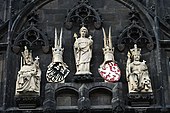
King John's eldest son Charles IV was elected King of the Romans in 1346 and succeeded his father as King of Bohemia in the same year. In 1348, Charles IV introduced the concept of the Crown of Bohemia (Corona regni Bohemiae in Latin), a term which designated the whole state hereditarily ruled by the kings of Bohemia, not only its core territory of Bohemia but also the incorporated provinces.[6]
The Luxembourg dynasty reached its high point, when Charles was crowned Holy Roman Emperor in 1355.[2] By his Imperial authority he decreed that the united Bohemian lands should endure regardless of dynastic developments, even if the Luxembourgs should die out.[7]
In 1367, he purchased
With King Wenceslaus, the decline of the Luxembourg dynasty began. He himself was deposed as King of the Romans in 1400. The Duchies of Brabant, Limburg (in 1406), and even Luxembourg itself (in 1411) were ceded to the French House of Valois-Burgundy; while the Margraviate of Brandenburg passed to the House of Hohenzollern (in 1415).[7] Nevertheless, the joint rule of the Bohemian Lands outlived the Hussite Wars and the extinction of the Luxembourg male line upon the death of Emperor Sigismund in 1437.
Jagiellons
Habsburgs
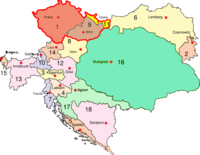
When Vladislas' only son
In the modern era, the remaining crown lands of Bohemia, Moravia and Austrian Silesia became constituent parts of the Austrian Empire in 1804, and later the Cisleithanian half of Austria-Hungary in 1867.
After World War I and the dissolution of the Austro-Hungarian monarchy, these became the historic regions usually referred to as the Czech lands forming the Czech Republic. Austrian Silesia with the Hlučín Region is today known as Czech Silesia, with the exception of eastern Cieszyn Silesia which passed to the Second Polish Republic in 1920.[7]
Bohemian territories
Crown lands
| Crown land | Type | Map | Capital or important city | Ethnic group | Religion | Notes |
|---|---|---|---|---|---|---|
| Kingdom | 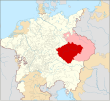
|
Prague | Bohemians (Czechs) Germans |
Lutheran
|
Royal dignity first bestowed upon Vratislaus II of Bohemia in 1085, hereditary since 1198 under King Ottokar I; Electorate of the Holy Roman Empire, confirmed by the Golden Bull of 1356. Included the Imperial domain of Egerland (Chebsko), obtained by King Wenceslaus II between 1291–1305, definitely given in pawn to Bohemia by King Louis IV in 1322 and subsequently ruled in personal union with Bohemia proper; as well as the County of Kladsko, established in 1459 and conquered by the Prussian king Frederick the Great in 1742. | |
Margraviate
|

|
Olomouc, Brno |
Czechs (Moravians) Germans |
Lutheran
|
Principalities of Olomouc, Brno and Bretislaus I in 1035. Elevated to a margraviate by the Přemyslid dukes in 1182, Bohemian fief from 1197.
| |
| Duchies | 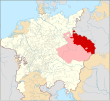
|
Wrocław | Germans Czechs/Bohemians Silesians Poles Moravians |
Lutheran
|
Many various duchies, acquired by the 1335 Maria Theresa lost Silesia in 1742 to the Prussian king Frederick the Great by the Treaty of Breslau, with the exception of its South-East part which became called Austrian Silesia (later Czech Silesia ). Today divided between Poland, the Czech Republic, and Germany.
| |
Upper Lusatia |
Margraviate | 
|
Bautzen | Germans Sorbs |
Lutheran
|
Former Meissen, finally incorporated by King John of Bohemia in 1319 (Bautzen) and 1329 (Görlitz). The Habsburg emperor Ferdinand II of Habsburg lost the Lusatias to the Electorate of Saxony with the 1635 Peace of Prague . Formally part of the Crown of Bohemia until 1815, today divided between Germany and Poland.
|
Lower Lusatia |
Margraviate | 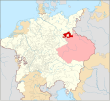
|
Lübben | Germans Sorbs |
Lutheran
|
Former March of Lusatia, acquired by Emperor Charles IV from Margrave Otto V of Brandenburg in 1367. The Habsburg emperor Ferdinand II of Habsburg lost the Lusatias to the Electorate of Saxony with the 1635 Peace of Prague. Formally part of the Crown of Bohemia between until 1815, today divided between Germany and Poland. |
(Zgorzelec) |
Duchy | 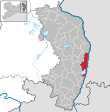
|
Görlitz | Germans Sorbs |
Roman Catholic
|
Duchy created by Emperor Charles IV for his third son John of Görlitz; he was the only Duke of Görlitz (Zgorzelec) from 1377 until his death. |
Other territories
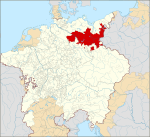
 The Brandenburg Electorate, acquired by Charles IV from Margrave Otto V in 1373. Charles' son Sigismund granted Brandenburg in 1415 to Frederick I, Elector of Brandenburg.
The Brandenburg Electorate, acquired by Charles IV from Margrave Otto V in 1373. Charles' son Sigismund granted Brandenburg in 1415 to Frederick I, Elector of Brandenburg.- King Ruprecht of Germany.
 Egerland
Egerland
Administrative divisions
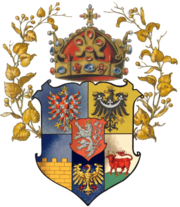
|
Kraje of Margraviate of Moravia |
|
See also
| History of the Czech lands |
|---|
 |
|
|
- Czech lands
- History of the Czech lands
- List of rulers of Bohemia
- Lands of the Crown of Saint Stephen
- Crown of the Kingdom of Poland
- Crown of Aragon
- Crown of Castille
- Real union
References
- ^ The Cambridge Modern History. The Macmillan Company. 1902. p. 331.
- ^ a b c d Geschichte der tschechischen öffentlichen Verwaltung Karel Schelle, Ilona Schelleová, GRIN Verlag, 2011 (in German and Czech)
- ^ "The Archives of the Crown of Bohemia". National Archive of the Czech Republic (Národní archiv ČR). Archived from the original on 20 December 2009. Retrieved 6 June 2014.
- ISBN 0-521-43155-7.
- ^ "Silesia – Pearl in the Crown of Bohemia". National Gallery in Prague (Národní galerie v Praze). Retrieved 6 June 2014.
- ^ Šitler, Jiří (12 July 2016). "From Bohemia to Czechia". Radio Prague International. Czech Radio. Retrieved 26 January 2020.
- ^ ISBN 3-88680-200-0. Retrieved 25 February 2013.
External links
- "Bohemia". BBC Radio 4 discussion with Norman Davies, Karin Friedrich and Robert Pynsent (In Our Time; April 11, 2002).


